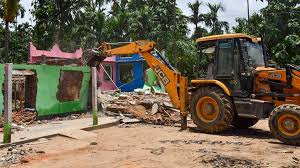Missed demographic invasion in lower and middle Assam, won’t let it repeat in upper Assam: Himanta’s rationale for mass evictions

Guwahati, July 16 – Assam Chief Minister Himanta Biswa Sarma defended the eviction drive in Upper Assam, declaring that he will not let demographic changes seen in Lower and Middle Assam repeat in the north and east.
Speaking in Sivasagar, Sarma said districts like Dhubri, Goalpara, and Barpeta had already lost their original character. He blamed this shift on unchecked settlements and warned that Upper Assam would not follow the same path.
“We missed the demographic invasion in Lower and Middle Assam. That mistake won’t be repeated here,” he said.
Evictions Pick Up Pace in Upper Assam
Over the last few weeks, authorities removed families from areas in Jorhat, Golaghat, and Sivasagar. Bulldozers cleared houses, mosques, and even schools. Security forces guarded the operation to avoid any resistance.
Officials say more than 1,800 families lived on land they did not legally own. Most affected families come from religious and linguistic minority groups.
Sarma: ‘We’re Protecting Indigenous Rights’
Sarma insisted that the action wasn’t against any one community. He said the goal is to defend land belonging to tribal and indigenous people.
“We are not targeting anyone based on faith. But forest and tribal land must be protected,” Sarma said.
He stressed that groups like the Ahoms, Mishings, and Sonowals must retain access to their traditional lands.
Criticism Mounts Over Eviction Drive
Opposition leaders and human rights activists strongly criticized the evictions. Congress leader Debabrata Saikia accused the government of targeting minorities to polarize voters before elections.
“This is clearly aimed at a specific community. It’s political, not administrative,” he said.
Groups like Amnesty India and the People’s Union for Civil Liberties raised concerns. They reported that many families were evicted without notice or alternative housing. Activist Anamika Deka said the state had violated basic human rights.
“Evicting families without shelter or compensation is inhumane,” she said.
Government Says Evictions Are Legal
The state government said it followed legal steps before the removals. Authorities offered rehabilitation only to families with valid land records.
Revenue Minister Jogen Mohan said the government won’t stop the drive.
“We are helping genuine settlers. But illegal occupation can’t continue,” he said.
Demographics or Political Messaging?
Sarma has used the term “demographic invasion” in several speeches. Critics argue that this language fuels fear among locals.
Political analyst Manjit Das said the term simplifies a complex issue. He explained that migration into Assam often happens because of poverty, floods, and lack of land in neighboring areas.
“Calling it an invasion may divide people rather than solve the problem,” he warned.
What’s Next for Assam?
The state plans more evictions in tribal belts, near Kaziranga National Park, and on tea garden lands. Sarma aims to clear all “illegal encroachments” by 2026.
At the same time, rights groups demand fair treatment for displaced families. They urge the government to respect human dignity and follow the law.
Assam remains a culturally rich and sensitive region. Balancing land protection with justice will remain one of its biggest challenges.






